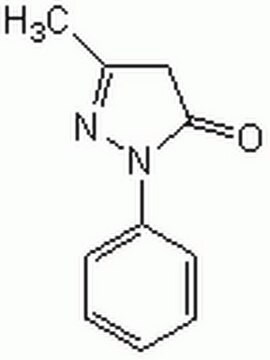SML0398
Salsolinol hydrobromide
≥96% (HPLC)
Synonim(y):
(R,S)-Salsolinol hydrobromide, 1,2,3,4-Tetrahydro-1-methylisoquinoline-6,7-diol hydrobromide, 1-Methyl-1,2,3,4-tetrahydroisoquinoline-6,7-diol hydrobromide, 1-Methyl-6,7-dihydroxy-1,2,3,4-tetrahydroisoquinoline 1,2,3,4-Tetrahydro-1-methylisoquinoline-6,7-diol hydrobromide; 1-Methyl-1,2,3,4-tetrahydroisoquinoline-6,7-diol hydrobromide;
About This Item
Polecane produkty
Poziom jakości
Próba
≥96% (HPLC)
Postać
powder
warunki przechowywania
desiccated
kolor
white to brown
rozpuszczalność
H2O: 5 mg/mL (warmed; clear solution)
temp. przechowywania
2-8°C
ciąg SMILES
Br.CC1NCCc2cc(O)c(O)cc12
InChI
1S/C10H13NO2.BrH/c1-6-8-5-10(13)9(12)4-7(8)2-3-11-6;/h4-6,11-13H,2-3H2,1H3;1H
Klucz InChI
OGMGXKJQIOUTTB-UHFFFAOYSA-N
Opis ogólny
Działania biochem./fizjol.
Cechy i korzyści
Hasło ostrzegawcze
Warning
Zwroty wskazujące rodzaj zagrożenia
Zwroty wskazujące środki ostrożności
Klasyfikacja zagrożeń
Eye Irrit. 2 - Skin Irrit. 2 - STOT SE 3
Organy docelowe
Respiratory system
Kod klasy składowania
11 - Combustible Solids
Klasa zagrożenia wodnego (WGK)
WGK 3
Temperatura zapłonu (°F)
Not applicable
Temperatura zapłonu (°C)
Not applicable
Certyfikaty analizy (CoA)
Poszukaj Certyfikaty analizy (CoA), wpisując numer partii/serii produktów. Numery serii i partii można znaleźć na etykiecie produktu po słowach „seria” lub „partia”.
Masz już ten produkt?
Dokumenty związane z niedawno zakupionymi produktami zostały zamieszczone w Bibliotece dokumentów.
Nasz zespół naukowców ma doświadczenie we wszystkich obszarach badań, w tym w naukach przyrodniczych, materiałoznawstwie, syntezie chemicznej, chromatografii, analityce i wielu innych dziedzinach.
Skontaktuj się z zespołem ds. pomocy technicznej








